Cerro Torre - East, northwest and north face, west ridge.
11. El Arca de los Vientos
- 11.1 Directa de la Mentira
- Other attempts to climb Cerro Torre from the north
550m 60˚ 6b+ C1
Alessandro Beltrami, Rolando Garibotti and Ermanno Salvaterra, 12-13/11/2005.
Description. El Arca is the only route to date that climbs Cerro Torre from the north. It starts via the American Torre Egger route, which it follows with some variations to the vicinity of the col between Egger and Torre. Above the triangular snowfield Beltrami, Garibotti and Salvaterra climbed 5 pitches on slabs to the left of the obvious gully, to eventually make one short rap back into the American line. From a small shoulder 40 meters above the col a rappel leads to the northwest face, and several mixed pitches lead to steep ground, involving some aid and one 15-meter pendulum to gain a small ledge on the north ridge. Four pitches up slabs and discontinuous flakes and cracks lead to the top of the north face and the west ridge. After a short mushroom pitch one rappel allows you to join the Ragni route, or like the first ascentionists you can climb straight up the ridge to join the Ragni for its last two pitches to the top (1200m altogether). No progression bolts were placed during this ascent. There is one progression bolt in the lower dihedral dating back to 1959 and one at the pendulum point on the NW face, placed by Garibotti in 2008 during the ascent of the Torres Traverse.
History. The first ascentionists climbed in one day to the small ledge on the north ridge where, after fixing one of their ropes on the first pitch up the north face they bivied. The evening before starting on the route they fixed their two climbing ropes in the first three pitches. To get so high in one day they short-fixed almost every pitch. The following day they climbed to the top of the north face and joined the Ragni route. In this section they failed to see two natural tunnels and therefore spent close to 10 hours to climb the last three mushroom pitches, summiting around 11PM. They bivied right below the summit mushroom and descended the SE ridge the next day.
Before El Arca was completed many parties had attempted to climb Cerro Torre from the north, with several of them reaching the col between Egger and Torre and four parties climbing above that point, either via the north face or the northwest face. Read lower down for more details.
Approach. Niponino to Noruegos to Glaciar Torre Superior.
Descent. Via the SE ridge or the Ragni route (the latter is safer and faster).
|
Photos (click to enlarge) 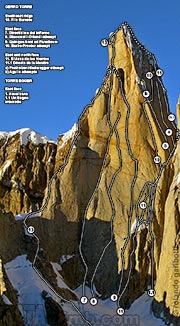
Cerro Torre east face
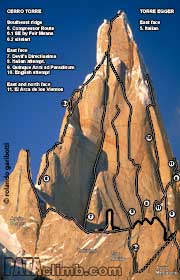
Cerro Torre southeast face 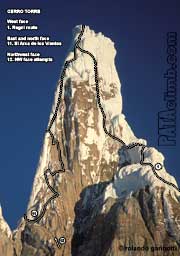
Cerro Torre northwest face 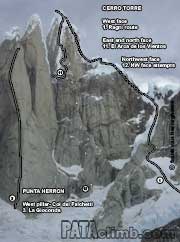
Cerro Torre northwest face 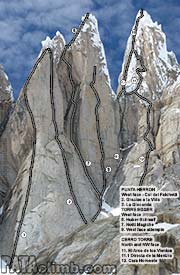
Cerro Torre and Punta Herron
west face

Cerro Torre north face 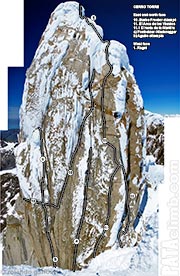
Cerro Torre north face 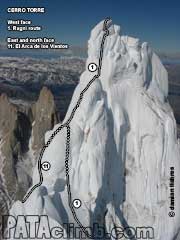
Cerro Torre west face
|
Other attempts to climb Cerro Torre from the north.
One attempt that is loosely linked to the north face took place in late January of 1959, when Toni Egger (AT) and Cesare Maestri (T) climbed on the east face of Cerro Torre, with help from Cesarino Fava (Italy), in hopes of trying the north face. They spent two weeks fixing ropes up a 250-meter dihedral (the same later climbed by Bragg, Donini and Wilson to do the first ascent of Torre Egger) to reach the base of an obvious triangular snowfield, where they made a big gear stash. Sometime during their attempt Egger perished. For more details about this attempt read the 2004 AAJ article A Mountain Unveiled that can be found in pdf format in the “knowledge” section of this website, where you will also find in-detail bibliography (on top of what is at the bottom of this page). Also read Completing the Puzzle.
Although Maestri never reached the col between Cerro Torre and Torre Egger he took the liberty to christen it col “della Conquista” (col of Conquest). This name was in response to Mauri and Bonatti’s naming of the col between Cerro Torre and Cerro Adela col “della Speranza” (col of hope, named so because they had hope to return to try the peak the following year). Regarding the col of Conquest name Maestri explained: "...in the mountains there is no such thing as hope, only the will to conquer. Hope is the weapon of the poor." Maestri not only lied but did so arrogantly, belittling Mauri and Bonatti who at the time were at the pinnacle of their careers. When a person’s will to conquer allows the use of such tools as tall tales, then indeed hope, the weapon of the honest, becomes meaningless. Since Maestri only reached the col in his fantasies and since the name was a direct jab at two of the most iconic alpinists of all time, in this website this col is simply referred to as the “Egger-Torre” col.
The most troubling aspect of Maestri and Fava's fabrication is that they failed to provide a plausible explanation to Toni Egger's family regarding the circumstances surrounding his death. Maestri and Fava also failed to return to Egger's family his diary (he was well known for writing lengthy entries), clothing, equipment or other belongings.
If any of the readers are troubled by the assessments regarding the Maestri affaire and believe that Maestri and Egger might have climbed Torre in 1959, we propose a two tier solution: come south, up the East and North side of Cerro Torre to get some first hand knowledge, form a well informed and educated opinion, with solid argumentation, and then write a response to “A Mountain Unveiled”, with all bibliographical citations and get it published by the AAJ, Berg or any other reputed journal. It will take a lot longer than an internet forum rant, but it will be a much more rewarding experience!
To the col and northwest face attempts.
In 1992, Salvaterra together with Adriano Cavallaro and Guido Bonvicini climbed to the small shoulder 50 meters above the col but bad weather forced him to retreat. Above the triangular snowfield he climbed the same four-pitches-up-slabs-left-of-the-ice-gully that 11 years later he would repeat to complete El Arca. The same three man tean also climbed the far left variation above the Triangular snowfield, up and obvious line of weakness to then traverse right to drop into the mixed terrain below the English dihedral (5 or 6 pitches, to 6b).
In May 1993 Tommy Bonapace, Gerold Dünser and Toni Ponholzer (AT) climbed to the shoulder above the col, rapped onto the northwest face and after climbing 150 meters got stuck in a bad storm that forced them to wait three full days before being able to retreat. They had a homemade porta-ledge, on which they could only sit but not lay down. After many days on the very exposed west side they crossed back over to the east side where “it felt like being in the tropics.” On that attempt they spent 9 days on the wall. Regarding their uncompromising style Tommy later on commented: “(...) We had already been here and could accomplish great routes by ‘fair means’. It was our fervent wish to climb without fixed ropes. That was for us the only acceptable manner in which to climb”. Ponholzer and Bonapace made many attempts to climb Torre from the north. Above the triangular snowfield they climbed several major variations to the American route. Once they climbed the obvious ice gully (3 or 4 pitches, AI5) and another time they climbed the same line of weakness to the far left that Bonvicini-Cavallaro and Salvaterra climbed, although it is unclear which of these two roped teams climbed this variation first.
Maurizio Giarolli, Elio Orlandi and Odoardo Ravizza (IT) had attempted the northwest face in 1994 from the west. See Italian attempt for more info. They managed to climb three pitches past the Bonapace, Dünser and Ponholzer 1993 highpoint, to reach the edge of the north face. El Arca de los Vientos connects various pieces of these two attempts and continues up the north face, and on to the summit.
In July of 2001 David Fasel, Stephan Siegrist, Thomas Ulrich (CH) and Michal Pitelka (CZ) climbed to the vicinity of the col between Egger and Torre, but after witnessing the collapse of many huge ice shields they decided to retreat, considering the route too dangerous. This attempt is mentioned here because of it’s uniqueness, it was during the middle of fucking winter! Hats off!!
North face attempts.
The north face is a 450-meter tall (10 to 12 pitches aprox) feature located between the edge of the big east face dihedral and the north ridge. The right, west side is shorter than the left, east side. Over the years there were three attempts to climb it. While El Arca de los Vientos climbs many pitches on the north face, a complete, bottom to top ascent of the face was only done in 2015 - see Directa de la Mentira.
In 1998 Maurizio Giarolli and Elio Orlandi (IT) made two attempts, climbing 8 to 10 new pitches right of the start of the American Egger route, on the east face of CT, joining it four pitches below the base of the English dihedral. Part way up to the Egger-Torre col they climbed up and left, onto the north face, climbing three pitches before giving up. They called their variation to the American Torre Egger route “Un sogno interrotto”.
A couple of months after the second Giarolli-Orlandi attempt, in January of 1999, Toni Ponholzer and Franz Niederegger (AT) climbed a series of variations to the American Torre Egger route to reach the base of the north face, to then follow the line attempted by Orlandi and Giarolli on the north face. They climbed five pitches past the Italian highpoint, reaching a point in the north face level with the summit of Torre Egger. At their high point the Austrians were likely just 20 meters to the right of the English east face dihedral attempt line, and about 80 from the top of the face. On their first day Ponholzer and Niederegger climbed 700 meters, but on the second day the difficulties encountered on the north face proved to be more than expected and they only managed to progress about 100 meters. On their third day on the wall, after climbing another 150 meters, fatigue and bad weather suggested caution and they retreated. They carried no sleeping bags.
In 2013 Tomas Aguilo and Nico Benedetti (AR) climbed a line to the left of Ponholzer's line, reaching the end of the Burke-Proctor traverse, from where they retreated.
In early 2019, Tomas Aguilo returned to his 2013 attempt, this time with Jorge Ackermann (AR) and Korra Pesce (IT). They managed to climb three pitches above the 2013 high-point, reaching the top of a small rime mushroom on the left side of the face. The first pitch up a corner, the second on a spur, and the third on a deep ice chimney. High temperatures and wind forced them to retreat from the top of the rime mushroom. They guess that the last third of the face will be the crux. To reach the base of the north face they followed the line of "Un Sogno Interrotto", climbed in 1998 by Elio Orlandi and Maurizio Giarolli. In all Aguilo and partners climbed twenty three pitches, nine of them on the north face. They bowed to return in the Spring of the 2019-20 season.
Bibliography.
Maestri: AAJ 1959 p. 317-318; AAJ 1973 p. 478; Ascent 1971 v1/5 p. 47; Mountain magazine 9 p. 32; Mountain magazine 18 p. 41-42; Mountain magazine 23 p. 20-27, p. 30-37; Mountain magazine 42 p. 38-43; Mountain Craft magazine 81 p. 22-25; Mountain Review magazine 9 p. 28-37; La Montagne 1960/4 p. 206-213; La Montagne 1973/1 p. 23-26; Vertical magazine 3 p. 73; Alp magazine 126 p. 38-44; Bolletino SAT 1959/2 p.1-9, p. 22-31 (Fava’s diary); CAI-Rivista Mensile 1959/1-2 p. 112, p. 114; CAI- Rivista Mensile 1961/7-8 p. 205-211; El Hogar 1959/2570 p. 77-81; El Hogar 1959/2572 p. 76; La Montaña 11 p. 77-80; La Montaña 13 p. 65-69; La Opinion, 27.2.1959, p. 13, Rio Gallegos; Lo Scarpone 1958/23 p. 1; Lo Scarpone 1959/1 p. 1; Lo Scarpone 1959/4 p. 1; Lo Scarpone 1959/5 p. 1; Lo Scarpone 1959/6 p. 1; Lo Scarpone 1959/7 p. 1; L’Europeo 704 (12.4.1959) p. 30-36; Maestri C. (1961) Arrampicare il mio Mestiere, Garzanti, Milano (p. 109-171); Maestri C. (1981) Il Ragno delle Dolomiti, Rizzoli, Milano; Maestri C. (1996) ...E se la vita continua, Baldini & Castoldi, Milano; Fava C. (1999) Patagonia, Terra di sogni infrati, Centro Documentazione Alpina, Torino; Climbing magazine 185 p. 72-81, 130-134; Rock and Ice magazine 3 p. 12-15; La Prensa 16/2/59 p. 7; Corriere degli Italiani 16/2/59 p. 1, 19/2/59 p. 3. For a more in detailed bibliography see the bibliography for “A mountain unveiled” in the “knowledge” section of this website.
Bonapace: Gipfelsturmer 1996 p. 21; AAJ 1994 p. 181, p.184.
Salvaterra 1993: CAI-Rivista Mensile 1993/5 p. 86.
Un sogno interrotto: High magazine 203 p. 82; AAJ 1999 p. 333; Alp magazine 172 p. 108.
|







